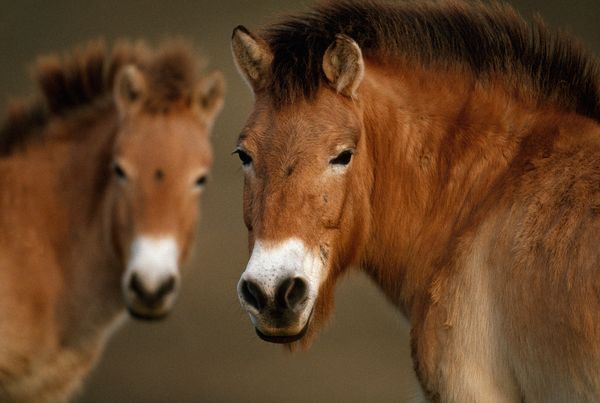World's Oldest Genome Sequenced From 700,000-Year-Old Horse DNA
A group of Przewalski's horses, once considered extinct in the wild.
DNA shines a light back into the past, showing us things that fossils can't. But how far back can that light extend?
Some of the oldest DNA sequences come from mastodon and polar bear fossils about 50,000 and 110,000 years old, respectively. But a new study published online today in the journal Nature reports the latest in the push for recovering ever more ancient DNA sequences. Samples from a horse leg bone more than 700,000 years old have yielded the oldest full genome known to date.
"We knew that sequencing ancient genomes as old as 70,000 to 80,000 years old was possible," said Ludovic Orlando, an evolutionary geneticist with the Natural History Museum of Denmark at the University of Copenhagen. "So we said, why not try even further back in time?"
The Pleistocene horse genome Orlando and colleagues pieced together helped them determine that the ancestor to the Equus lineage—the group that gave rise to modern horses, zebras, and donkeys—arose 4 to 4.5 million years ago, or about two million years earlier than previously thought.
The ancient horse genome also allowed the team to determine the evolutionary relationship between modern domestic horses and the endangered Przewalski's horse, a native to the Mongolian steppes that represents the last living breed of wild horse.
The team found that Przewalski's horses were an offshoot of the lineage that gave rise to domestic horses. The two groups diverged around 50,000 years ago.
Once considered extinct in the wild, Przewalski's horse was re-introduced into the wild from a captive population of only a few dozen. While this number suggests that the genetic diversity of the species might be too small to support, the study shows that Przewalski's horses are in fact more genetically diverse than domestic breeds such as Arabian and Icelandic horses.
"We think that there's enough genetic diversity within the Przewalski's horse to keep conservation efforts viable," Orlando said.
Cold Storage
Extracting ancient genomes from long-dead samples is labor intensive, and there is a limit to how far back one can go.
Studies on the half-life of DNA suggest that even under ideal circumstances, DNA sequences older than 1.5 million years will be too short to be readable. So it's highly unlikely that DNA will be recovered from dinosaurs, since they disappeared 65 million years ago, except for the lineage leading to modern birds.
But the preservation environment of an ancient sample can help extend the amount of time DNA has before it degrades past the point of being recoverable.
"Cold is good," said Orlando. Frozen is even better, because liquid water isn't present to degrade DNA molecules.
The six-inch (15-centimeter) horse leg bone the team analyzed originated in the Yukon Territory of western Canada. Permafrost kept the remains in a kind of cold storage for about 735,000 years until scientists dug it out in 2003.
To determine whether there might be any biological molecules left in the sample, Orlando and colleagues first looked to see if they could spot amino acids from collagen—a protein found in bone—in the specimen.
Once they identified and successfully sequenced those proteins, the researchers moved on to trying to extract DNA from the ancient leg bone.
As is the case with the majority of ancient fossils, most of the DNA they found was from bacteria that had populated the bone after the horse died. Using DNA from modern horses as a reference, the team was able to identify "endogenous" DNA that belonged to the ancient horse itself.
"We sequenced 12 billion DNA molecules, of which 40 million [were of] horse origin," said Orlando. "There was a bit of horse DNA in an ocean of microbial DNA."
A New World
The recovery of a genome almost an order of magnitude older than any previous genomic information opens up a wide range of new targets for studying fossils at the genetic level, possibly including ancient human species, if they lived in cooler environments.
"You name it—what are your favorite Pleistocene beasts?" wrote Hendrik Poinar, an evolutionary geneticist at McMaster University in Ontario, Canada, in an email.
Poinar, who was not involved in the current study, would like to see this applied to elephant evolution. "This should address issues related to the origin of hair and size plasticity and how they adapted to very different ecologies."
He was not surprised that researchers were able to sequence a complete genome from 700,000 years ago. It just takes time and money, Poinar said.
But he also points out that sequencing ancient genomes is more about preservation in various environments than the age of a specimen. "I am sure there will be older genomes soon enough."
Jane J. Lee
National Geographic
Published June 26, 2013












